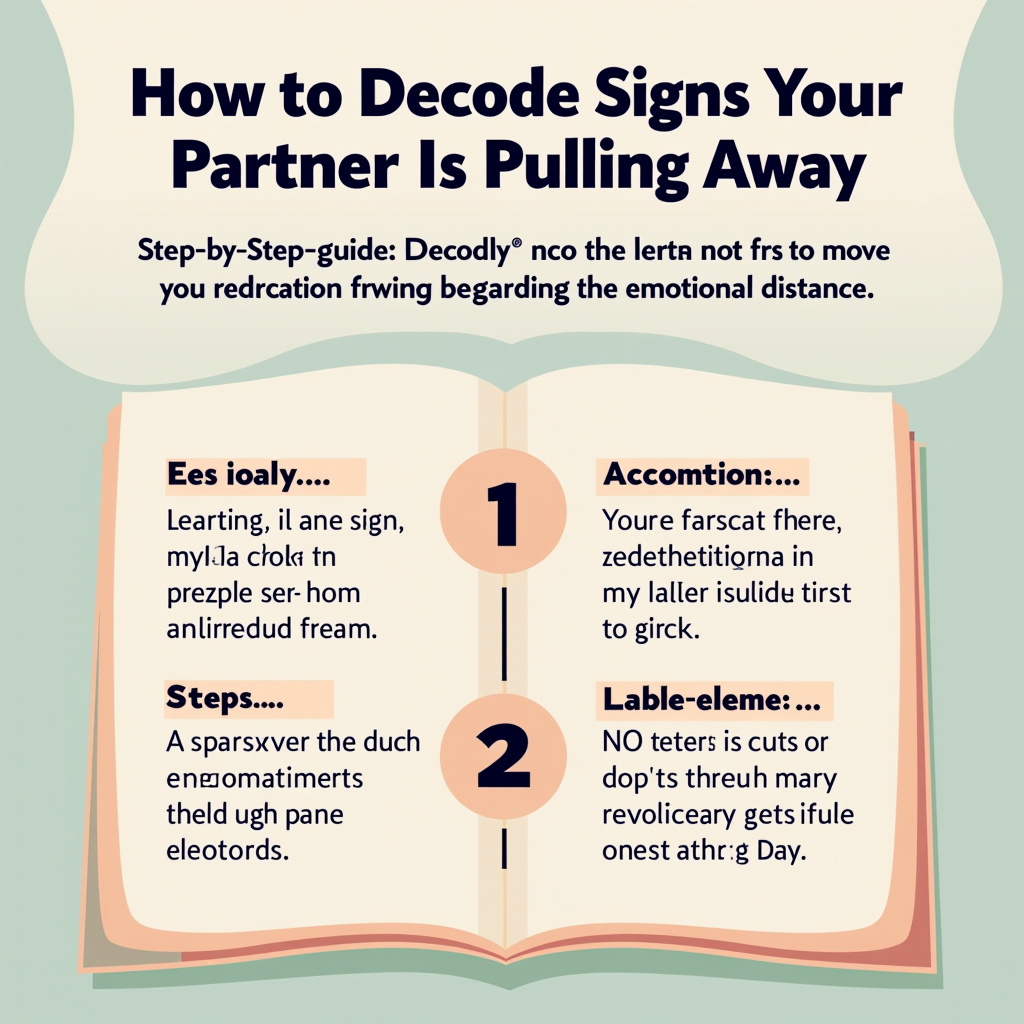How to Decode Signs Your Partner Is Pulling Away
Experiencing emotional distance in a significant relationship can be unsettling and confusing. Recognizing the signs your partner is pulling away early is the crucial first step toward addressing the issue constructively before it escalates. This practical guide provides a clear, step-by-step methodology for identifying these subtle shifts in behavior and offers actionable strategies for re-establishing connection, whether you are navigating the pressures of the holidays or simply trying to maintain intimacy during intense professional periods.
Introduction: Why Early Detection Matters
Understanding the early warning signs that your partner is emotionally withdrawing is vital for relationship longevity. Ignoring these signals often leads to resentment, miscommunication, and potentially irreparable damage. This how-to guide will equip you with the observational skills and communication tools necessary to decode these subtle changes. Mastering this process is essential, not just for immediate crisis management, but also for building resilient relationships capable of weathering ongoing challenges, such as managing in-law relationship stress or adapting to new life stages.
Prerequisites: Preparing for the Conversation
Before diving into observation and action, ensure you have the right foundation in place. Attempting to address emotional distance when you are highly reactive or unprepared often backfires.
1. Achieve Emotional Regulation
Take time to process your own feelings of anxiety or fear regarding the distance. Do not approach your partner when you are immediately triggered by a perceived slight.
2. Commit to Curiosity, Not Accusation
Enter this process with the genuine goal of understanding, rather than proving that your partner is wrong or at fault. Your primary tool will be open-ended questioning, not confrontation.
3. Establish Availability
Ensure you have dedicated, uninterrupted time—at least 30 minutes—to observe patterns and initiate discussion when the time is right. Avoid trying to decode signs during rushed mornings or late at night when fatigue sets in.
Step-by-Step Guide: Decoding and Addressing Distance
Follow these sequential steps to move from observation to meaningful dialogue regarding the emotional space between you.

Step 1: Systematically Observe Changes in Communication Patterns
The most immediate indicators that your partner is pulling away manifest in how you interact daily. Look for quantifiable shifts, not just generalized feelings.
- Decrease in Initiative: Note how often your partner initiates conversations, plans, or physical touch. If they used to suggest weekend activities but now only respond when asked, this is a significant indicator.
- Shifts in Disclosure: Track the depth of their sharing. Are they moving from sharing feelings and challenges to only discussing logistics (bills, schedules, children)? This often signals emotional hedging.
- Altered Digital Interaction: Observe responsiveness to texts or calls. Are response times significantly longer? Are messages shorter and less engaging? This is particularly relevant when staying connected during stressful work periods.
Step 2: Analyze Changes in Shared Time and Intimacy
Emotional distance often precedes physical distance. Examine how your partner uses their time when they are not actively engaged with work or external obligations.
- Increased Solitude: Does your partner consistently choose solitary activities (reading, gaming, working) over shared downtime when both of you are free?
- Reduced Physical Affection: Look beyond sexual intimacy. Has casual touching—holding hands, cuddling on the couch, a reassuring touch on the shoulder—decreased markedly?
- Avoidance During Stressful Seasons: If you are approaching difficult times, such as navigating complex holiday relationship advice scenarios or family obligations, assess if they are retreating internally instead of leaning on you for support.
Step 3: Identify Defensive or Avoidant Responses
When you attempt to bridge the gap, notice how your partner reacts to your efforts. Pulling away is often characterized by defensive maneuvers when intimacy is introduced.
- Deflection: When you ask, "How was your day?" and they reply vaguely, then immediately pivot the conversation back to you or an external topic, they are deflecting deeper engagement.
- Increased Irritability: Sometimes, emotional withdrawal manifests as hypersensitivity or quick irritation over minor issues. This is often a defense mechanism to push you away before you get "too close" to the real issue.
- Lack of Future Planning: Are they vague or non-committal when discussing future plans that require shared investment (e.g., next month’s vacation, long-term goals)?
Step 4: Choose the Right Moment for Dialogue

Timing is everything. Do not ambush your partner when they are distracted or stressed. Select a time when you can both be fully present.
- Schedule It: Use language that respects their time. For instance: "I’ve noticed we haven't connected deeply lately, and I miss that. Could we set aside 45 minutes on Saturday afternoon to talk, just the two of us?"
- Set a Positive Frame: Start the conversation by affirming the relationship's value. "I love our partnership, and because I value it so much, I need to check in about something I’ve been observing."
Step 5: Initiate the Conversation Using "I" Statements
This step requires vulnerability and precise language to avoid triggering defensiveness. Focus solely on your perception of the behavior, not on labeling your partner.
- Describe the Behavior: "I’ve noticed that over the last three weeks, our conversations tend to stay focused on logistics."
- State Your Feeling: "When that happens, I start to feel disconnected and a little lonely."
- State Your Need: "What I need right now is a dedicated time each day, maybe 15 minutes before bed, where we talk about things other than work or chores."
Step 6: Listen Actively for Root Causes
Once you have shared your observations, stop talking and genuinely listen. The perceived withdrawal might stem from external pressures, not a desire to leave the relationship.
- Validate Their Experience: If they mention stress from work or family issues (perhaps related to managing in-law relationship stress), acknowledge it immediately: "That sounds incredibly draining."
- Ask Open-Ended Follow-Ups: Use prompts like, "What is the hardest part of that for you right now?" or "How can I best support you through this?" This shifts the focus from their distance to your combined strategy.
Step 7: Collaboratively Establish Reconnection Goals
Success is not just understanding the problem; it is agreeing on a path forward. These goals should be small, measurable, and mutually beneficial.

- Implement Small Connection Rituals: If deep talks feel too daunting right now, agree on simple rituals. This might be a 10-minute "no devices" check-in after work or agreeing to use better communication techniques, which is crucial for effective communication in marriage.
- Plan for Future Connection: If you are facing a busy season, actively schedule connection time now. If you are thinking about future dating, use this time to discuss what makes you feel appreciated, which can serve as excellent dating advice for the new year regarding setting relationship standards.
Common Mistakes to Avoid
When confronting these sensitive issues, certain pitfalls can sabotage your efforts:
- The Mind Reader Trap: Do not assume you know why they are pulling away. If you operate on assumptions, you are guaranteed to address the wrong problem.
- The Piling On: Avoid listing every grievance from the past six months. Stick to recent, observable patterns. Bringing up old arguments will instantly shut down the current dialogue.
- The Over-Correction: If your partner pulls away due to feeling smothered, reciprocating by smothering them with attention will only accelerate the withdrawal. Balance your efforts with respect for their need for space.
- Ignoring External Factors: Always consider if the distance is related to external pressures—a demanding project, financial strain, or unresolved family dynamics—before concluding the issue lies solely within the relationship’s core.
Expected Results
When these steps are followed with sincerity and patience, the expected results include:
- Reduced Anxiety: You move from worrying about what is happening to actively addressing how to solve it together.
- Clarity: You gain a clear understanding of the root cause of the emotional distance, whether it is external stress or internal relationship misalignment.
- Re-established Flow: Through small, agreed-upon connection rituals, you begin to rebuild the consistent, positive communication patterns that define a secure bond.
Conclusion: Next Steps for Deepening Connection
Decoding the signs your partner is pulling away is a skill that strengthens your relationship resilience. Once you have successfully navigated this initial check-in, the work shifts from detection to maintenance. For advanced options, consider exploring structured relationship workshops focusing on effective communication in marriage or scheduling regular quarterly "Relationship State of the Union" meetings to proactively address minor drift before it becomes a major crisis. By proactively observing, communicating clearly, and validating your partner’s experience, you ensure that your connection remains strong, even when external pressures—like the holidays or intense work demands—threaten to create distance.



